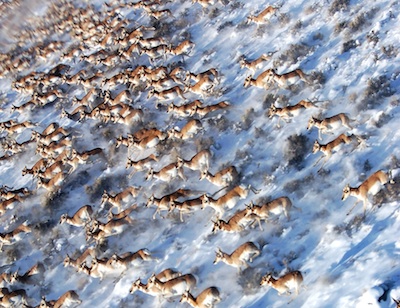The need to prevent national park units from turning into biological islands, cut off from other wild lands by development, is not a new worry. But a recent study reinforces the value of ensuring migrational corridors survive.
Twenty years ago the "Yellowstone to Yukon" initiative, or Y2Y, was launched through the desire of Harvey Locke, a Canadian environmentalist, to see the Northern Rocky Mountains protected for wildlife.
"(T)he idea of establishing new protected areas and wildlife corridors throughout the mountain ranges from Yellowstone National Park to the Yukon became more formalized in December 1993 when a group of scientists and conservationists convened in Kananaskis, Alberta, to pore over maps and examine critical landscapes in the region," notes Y2Y's webpage. "The group came to the conclusion that a positive vision tying together conservation goals from Yellowstone to the Yukon was appropriate and necessary."

Pronghorn antelope -- the longest land migrant in the contiguous USA (photo from south of Grand Teton National Park). Photo by Joel Berger.
National Park Service staff, along with outside experts, including Wildlife Conservation Society scientists, recently met to develop recommendations to conserve aerial, marine, and terrestrial populations of migrating wildlife that move in and out of U.S. national parks. Their resulting paper, Optimism and Challenge for Science-based Conservation of Migratory Species in and out of U.S. National Parks, draws a blueprint "for the conservation of species that seasonally occupy America’s national parks."
While it might be difficult to envision if you live in a heavily populated and urbanized areas, there are quite a few wildlife migrations in play these days.
"Examples of wildlife that move in and out of national parks include pronghorn that migrate to lower elevation areas seasonally in the American West, humpback whales that calve their young near Hawaii and move through shipping lanes to summer feeding areas in Southeast Alaska, and shorebirds like the American golden plover that breeds in Arctic Alaska and migrates to wintering grounds in southern South America," the study notes.
Although NPS manages ∼36 million hectares of land and water in 401 units, there is no centralized program to conserve wild animals reliant on NPS units that also migrate hundreds to thousands of kilometers beyond parks. Migrations are imperiled by habitat destruction, unsustainable harvest, climate change, and other impediments. A successful program to counter these challenges requires public support, national and international outreach, and flourishing migrant populations.-- From the study's abstract
“The challenges of conserving migratory species that use national parks involve daunting ecological, social and philosophical questions,” said lead author Joel Berger, a professor at the University of Montana and Senior Scientist with WCS. “If we can educate landowners, counties and agencies in the U.S., and even foreign governments, to see that migration is an essential wildlife process, the likelihood that we can conserve these species increases. There is reason for optimism.”
Adding to that optimism are existing precedents such as that seen in the Path of the Pronghorn—the first federally- designated migration corridor in the United States. Collaboration among the NPS, WCS and Bridger Teton National Forest led to the identification and protection of this 93-mile pronghorn migration route that links the animals’ wintering grounds in the Upper Green River Basin of Wyoming and summering grounds in Grand Teton National Park.
"This collaborative effort, both nationally and internationally, comes at a time when the need to conserve key species that move across local jurisdictions (including in and out of our national parks) could not be higher," said Dr. Herbert C. Frost the Park Service's associate director for natural resource stewardship and science and co-author of the paper.
Among the many recommendations in the article is to launch a series of conservation efforts with high-profile migratory species. By so doing, “these pilot projects may provide transferable lessons for a more comprehensive effort and build capacity for a migratory species initiative within and outside of NPS.”
“The National Park Service is internationally recognized as a leader in managing parks and protecting our wildlife heritage," said Steve Zack, a senior scientist with the Wildlife Conservation Society. "For migratory species, protected areas are essential but not sufficient. We look forward to working more with NPS in conserving long-distant species such as those that nest in our national parks but winter south of the Equator and need coordinated conservation across their range.”
However, the study's authors note it will take a rethinking of sorts by individual park managers to succeed with this effort.
"Capacity building will entail increasing the limited knowledge among park staff about how and where species or populations migrate, conditions that enable migration, and identifying species' needs and resolving them both within and beyond parks," they wrote. "Building capacity will also require ensuring that park superintendents and staff at all levels support conservation beyond statutory borders."
If you have access to the Wiley Online Library, you can find the full report here.



Add comment